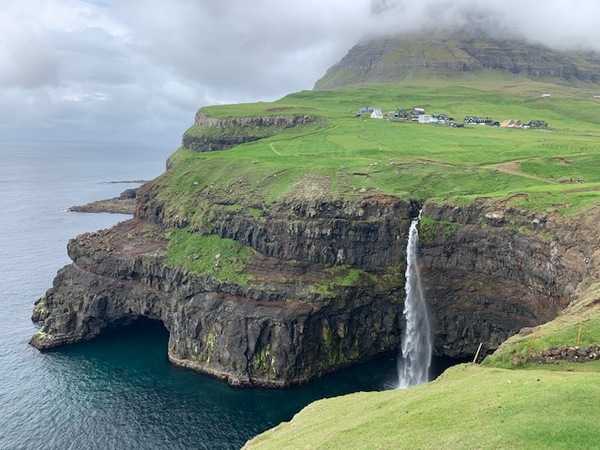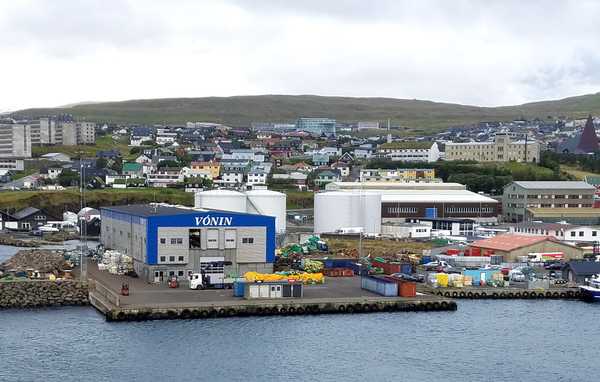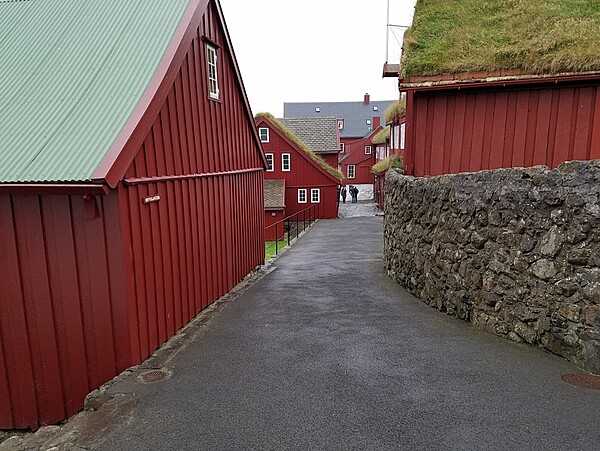Faroe Islands - FO - FRO - Europe
Last updated: December 11, 2025

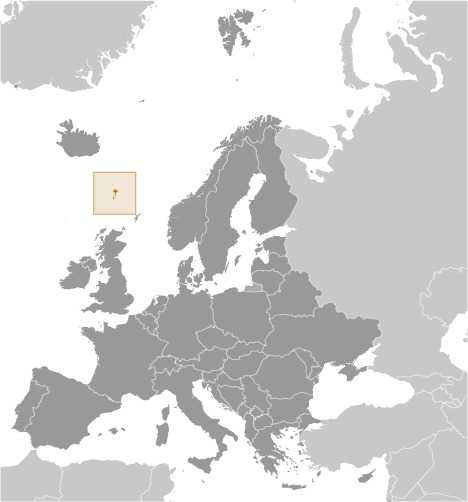
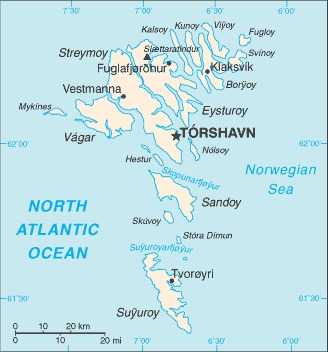
Faroe Islands Images
Faroe Islands Factbook Data
Dependency status
part of the Kingdom of Denmark; self-governing overseas administrative division of Denmark since 1948
Diplomatic representation from the US
embassy: none (self-governing overseas administrative division of Denmark)
Age structure
0-14 years: 20% (male 5,489/female 5,122)
15-64 years: 61.5% (male 17,188/female 15,346)
65 years and over: 18.5% (2024 est.) (male 4,723/female 5,065)
15-64 years: 61.5% (male 17,188/female 15,346)
65 years and over: 18.5% (2024 est.) (male 4,723/female 5,065)
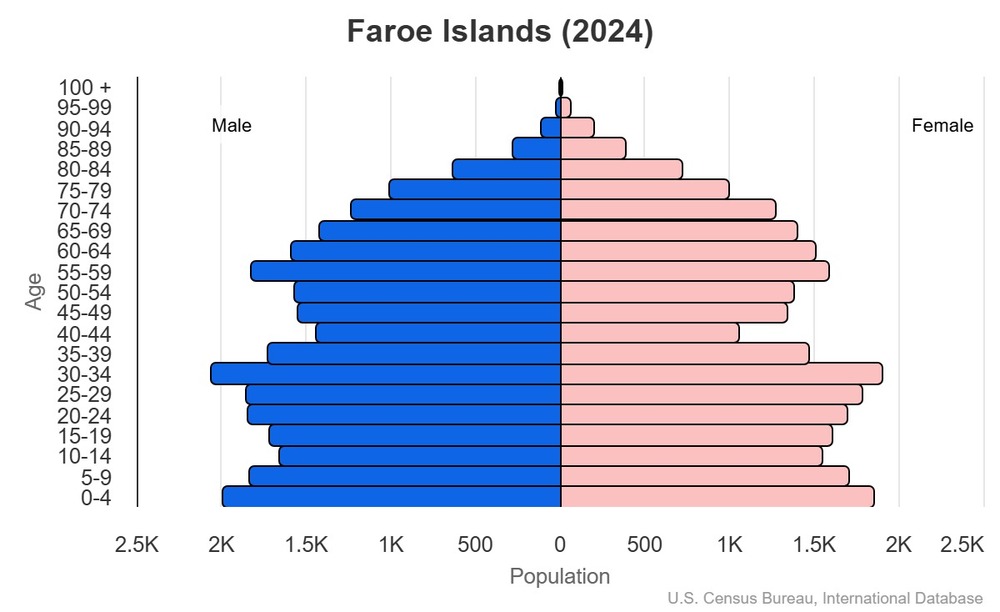
This is the population pyramid for Faroe Islands. A population pyramid illustrates the age and sex structure of a country's population and may provide insights about political and social stability, as well as economic development. The population is distributed along the horizontal axis, with males shown on the left and females on the right. The male and female populations are broken down into 5-year age groups represented as horizontal bars along the vertical axis, with the youngest age groups at the bottom and the oldest at the top. The shape of the population pyramid gradually evolves over time based on fertility, mortality, and international migration trends.
For additional information, please see the entry for Population pyramid on the Definitions and Notes page.
For additional information, please see the entry for Population pyramid on the Definitions and Notes page.
Geographic coordinates
62 00 N, 7 00 W
Sex ratio
at birth: 1.07 male(s)/female
0-14 years: 1.07 male(s)/female
15-64 years: 1.12 male(s)/female
65 years and over: 0.93 male(s)/female
total population: 1.07 male(s)/female (2024 est.)
0-14 years: 1.07 male(s)/female
15-64 years: 1.12 male(s)/female
65 years and over: 0.93 male(s)/female
total population: 1.07 male(s)/female (2024 est.)
Natural hazards
strong winds and heavy rains can occur throughout the year
Area - comparative
eight times the size of Washington, D.C.
Background
The Faroe Islands were already populated by about A.D. 500, but whether the original settlers were Celtic or early Norse (or someone else) has yet to be determined. Viking settlers arrived on the islands in the 9th century, and the islands served as an important stepping stone for medieval Viking exploration of the North Atlantic. The islands have been connected politically to Denmark since the 14th century, and today the Faroe Islands are a self-governing dependency of Denmark. The Home Rule Act of 1948 granted a high degree of self-government to the Faroese, who have autonomy over most internal affairs and external trade, while Denmark is responsible for justice, defense, and some foreign affairs. The Faroe Islands are not part of the European Union.
Environmental issues
coastal erosion, landslides and rockfalls, flash flooding, wind storms; oil spills
Exports - commodities
fish and fish products (2021)
Exports - partners
Russia 26.4%, UK 14.1%, Germany 8.4%, China 7.9%, Spain 6.8%, Denmark 6.2%, US 4.7%, Poland 4.4%, Norway 4.1% (2017)
Administrative divisions
29 first-order municipalities (kommunur, singular - kommuna) Eidhi, Eystur, Famjin, Fuglafjordhur, Fugloy, Hov, Husavik, Hvalba, Hvannasund, Klaksvik, Kunoy, Kvivik, Nes, Porkeri, Runavik, Sandur, Sjovar, Skalavik, Skopun, Skuvoy, Sorvagur, Sumba, Sunda, Torshavn, Tvoroyri, Vagar, Vagur, Vestmanna, Vidhareidhi
Agricultural products
milk, potatoes, lamb/mutton, sheepskins, sheep offal, beef, sheep fat, beef offal, cattle hides, beef suet (2023)
note: top ten agricultural products based on tonnage
note: top ten agricultural products based on tonnage
Military and security forces
no regular military forces or conscription
Capital
name: Torshavn
geographic coordinates: 62 00 N, 6 46 W
time difference: UTC 0 (5 hours ahead of Washington, DC, during Standard Time)
daylight saving time: +1hr, begins last Sunday in March; ends last Sunday in October
etymology: the name means "Thor's harbor" in Danish
geographic coordinates: 62 00 N, 6 46 W
time difference: UTC 0 (5 hours ahead of Washington, DC, during Standard Time)
daylight saving time: +1hr, begins last Sunday in March; ends last Sunday in October
etymology: the name means "Thor's harbor" in Danish
Imports - commodities
goods for household consumption, machinery and transport equipment, fuels, raw materials and semi-manufactures, cars
Climate
mild winters, cool summers; usually overcast; foggy, windy
Coastline
1,117 km
Constitution
history: 5 June 1953 (Danish Constitution), 23 March 1948 (Home Rule Act), and 24 June 2005 (Takeover Act) serve as the Faroe Islands' constitutional position in the Unity of the Realm
amendment process: see entry for Denmark
amendment process: see entry for Denmark
Exchange rates
Danish kroner (DKK) per US dollar -
Exchange rates:
6.894 (2024 est.)
6.89 (2023 est.)
7.076 (2022 est.)
6.287 (2021 est.)
6.542 (2020 est.)
Exchange rates:
6.894 (2024 est.)
6.89 (2023 est.)
7.076 (2022 est.)
6.287 (2021 est.)
6.542 (2020 est.)
Executive branch
chief of state: King FREDERIK X of Denmark (since 14 January 2024), represented by High Commissioner Lene Moyell JOHANSEN, chief administrative officer (since 15 May 2017) (2024)
head of government: Prime Minister Aksel V. JOHANNESEN (since 22 December 2022)
cabinet: Landsstyri appointed by the prime minister
election/appointment process: the monarchy is hereditary; high commissioner appointed by the monarch; following legislative elections, the Parliament usually elects the leader of the majority party or majority coalition as the prime minister
most recent election date: 8 December 2022
expected date of next election: 2026
head of government: Prime Minister Aksel V. JOHANNESEN (since 22 December 2022)
cabinet: Landsstyri appointed by the prime minister
election/appointment process: the monarchy is hereditary; high commissioner appointed by the monarch; following legislative elections, the Parliament usually elects the leader of the majority party or majority coalition as the prime minister
most recent election date: 8 December 2022
expected date of next election: 2026
Flag
description: white with a red cross outlined in blue that extends to the edges of the flag; the cross is shifted toward the left side in the style of the Dannebrog (Danish flag)
meaning: white represents waves breaking on the shore; red and blue are traditional Faroese colors
history: the flag is referred to as Merkid, meaning "the banner" or "the mark;" a group of students designed it in 1919, although it wasn't officially adopted until 1940
note: resembles the flags of Iceland and Norway; uses the same three colors in a different sequence and with a lighter blue
meaning: white represents waves breaking on the shore; red and blue are traditional Faroese colors
history: the flag is referred to as Merkid, meaning "the banner" or "the mark;" a group of students designed it in 1919, although it wasn't officially adopted until 1940
note: resembles the flags of Iceland and Norway; uses the same three colors in a different sequence and with a lighter blue
Independence
none (self-governing overseas administrative division of Denmark)
Industries
fishing, fish processing, tourism, small ship repair and refurbishment, handicrafts
Judicial branch
highest court(s): Faroese Court or Raett (Rett in Danish) decides both civil and criminal cases; the Court is part of the Danish legal system
subordinate courts: Court of the First Instance or Tribunal de Première Instance; Court of Administrative Law or Tribunal Administratif; Mixed Commercial Court; Land Court
subordinate courts: Court of the First Instance or Tribunal de Première Instance; Court of Administrative Law or Tribunal Administratif; Mixed Commercial Court; Land Court
Land boundaries
total: 0 km
Land use
agricultural land: 70.1% (2023 est.)
arable land: 0.1% (2023 est.)
permanent crops: 0% (2022 est.)
permanent pasture: 70.1% (2023 est.)
forest: 0.1% (2023 est.)
other: 29.8% (2023 est.)
arable land: 0.1% (2023 est.)
permanent crops: 0% (2022 est.)
permanent pasture: 70.1% (2023 est.)
forest: 0.1% (2023 est.)
other: 29.8% (2023 est.)
Legal system
the laws of Denmark apply
Legislative branch
legislature name: Faroese Parliament (Logting)
legislative structure: unicameral
number of seats: 33 (directly elected)
electoral system: proportional representation
scope of elections: full renewal
term in office: 4 years
most recent election date: 12/8/2022
parties elected and seats per party: JF (9); B (7); A (6); E (6); F (3); H (2)
percentage of women in chamber: 27.3%
expected date of next election: 2026
note: the Faroe Islands elect 2 members to the Danish Parliament to serve 4-year terms
legislative structure: unicameral
number of seats: 33 (directly elected)
electoral system: proportional representation
scope of elections: full renewal
term in office: 4 years
most recent election date: 12/8/2022
parties elected and seats per party: JF (9); B (7); A (6); E (6); F (3); H (2)
percentage of women in chamber: 27.3%
expected date of next election: 2026
note: the Faroe Islands elect 2 members to the Danish Parliament to serve 4-year terms
Maritime claims
territorial sea: 12 nm
continental shelf: 200 nm or agreed boundaries or median line
exclusive fishing zone: 200 nm or agreed boundaries or median line
continental shelf: 200 nm or agreed boundaries or median line
exclusive fishing zone: 200 nm or agreed boundaries or median line
International organization participation
Arctic Council, IMO (associate), NC, NIB, UNESCO (associate), UPU
National holiday
Olaifest (Olavsoka), 29 July (1030)
note: commemorates the death in battle of King OLAF II of Norway, later St. OLAF
note: commemorates the death in battle of King OLAF II of Norway, later St. OLAF
Nationality
noun: Faroese (singular and plural)
adjective: Faroese
adjective: Faroese
Natural resources
fish, whales, hydropower, possible oil and gas
Geography - note
archipelago of 17 inhabited islands, one uninhabited island, and a few uninhabited islets; strategically located along important sea lanes in northeastern Atlantic; precipitous terrain limits habitation to small coastal lowlands
Economic overview
high-income Danish territorial economy; party neither to the EU nor the Schengen Area; associate Nordic Council member; very low unemployment; unique foreign ownership allowance in fishing industry; known salmon exporter; growing IT industries
Political parties
Center Party or H (Midflokkurin)
People's Party or A (Folkaflokkurin)
Progress Party or F (Framsokn)
Republic or E (Tjodveldi) (formerly the Republican Party)
Self-Government Party or D (Sjalvstyri or Sjalvstyrisflokkurin)
Social Democratic Party or JF (Javnadarflokkurin) or JF
Union Party or B (Sambandsflokkurin)
People's Party or A (Folkaflokkurin)
Progress Party or F (Framsokn)
Republic or E (Tjodveldi) (formerly the Republican Party)
Self-Government Party or D (Sjalvstyri or Sjalvstyrisflokkurin)
Social Democratic Party or JF (Javnadarflokkurin) or JF
Union Party or B (Sambandsflokkurin)
Suffrage
18 years of age; universal
Terrain
rugged, rocky, some low peaks; cliffs along most of coast
Government type
parliamentary democracy (Faroese Parliament); part of the Kingdom of Denmark
Military - note
the Government of Denmark has responsibility for defense; as such, the Danish military’s Joint Arctic Command in Nuuk, Greenland is responsible for coordinating the defense of the Faroe Islands; the Joint Arctic Command has a contact element in the capital of Torshavn
Country name
conventional long form: none
conventional short form: Faroe Islands
local long form: none
local short form: Foroyar
etymology: the archipelago's name derives from the Old Norse name Faeroyar, meaning "sheep islands;" faer means "sheep," and -oyar means "islands"
conventional short form: Faroe Islands
local long form: none
local short form: Foroyar
etymology: the archipelago's name derives from the Old Norse name Faeroyar, meaning "sheep islands;" faer means "sheep," and -oyar means "islands"
Location
Northern Europe, island group between the Norwegian Sea and the North Atlantic Ocean, about halfway between Iceland and Norway
Map references
Europe
Diplomatic representation in the US
none (self-governing overseas administrative division of Denmark)
Internet users
percent of population: 98% (2017 est.)
Internet country code
.fo
GDP (official exchange rate)
$3.907 billion (2023 est.)
note: data in current dollars at official exchange rate
note: data in current dollars at official exchange rate
Urbanization
urban population: 43% of total population (2023)
rate of urbanization: 0.89% annual rate of change (2020-25 est.)
rate of urbanization: 0.89% annual rate of change (2020-25 est.)
Broadcast media
1 publicly owned TV station; the Faroese telecommunications company distributes local and international channels through its digital terrestrial network; publicly owned radio station supplemented by 3 privately owned stations broadcasting over multiple frequencies
National anthem(s)
title: "Mitt alfagra land" (My Fairest Land)
lyrics/music: Simun av SKAROI/Peter ALBERG
history: adopted 1948; the anthem is also known as "Tu alfagra land mitt" (Thou Fairest Land of Mine); as a self-governing overseas administrative division of Denmark, the Faroe Islands are permitted to have their own national anthem
lyrics/music: Simun av SKAROI/Peter ALBERG
history: adopted 1948; the anthem is also known as "Tu alfagra land mitt" (Thou Fairest Land of Mine); as a self-governing overseas administrative division of Denmark, the Faroe Islands are permitted to have their own national anthem
Major urban areas - population
21,000 TORSHAVN (capital) (2018)
Physician density
2.62 physicians/1,000 population (2016)
National symbol(s)
ram
GDP - composition, by end use
household consumption: 40.6% (2023 est.)
government consumption: 27.3% (2023 est.)
investment in fixed capital: 31% (2023 est.)
investment in inventories: 0% (2023 est.)
exports of goods and services: 57.7% (2023 est.)
imports of goods and services: -56.6% (2023 est.)
note: figures may not total 100% due to rounding or gaps in data collection
government consumption: 27.3% (2023 est.)
investment in fixed capital: 31% (2023 est.)
investment in inventories: 0% (2023 est.)
exports of goods and services: 57.7% (2023 est.)
imports of goods and services: -56.6% (2023 est.)
note: figures may not total 100% due to rounding or gaps in data collection
Population distribution
the island of Streymoy is by far the most populous with over 40% of the population; it has approximately twice as many inhabitants as Eysturoy, the second most populous island; seven of the inhabited islands have fewer than 100 people
Electricity access
electrification - total population: 100% (2022 est.)
electrification - urban areas: 99.9%
electrification - rural areas: 100%
electrification - urban areas: 99.9%
electrification - rural areas: 100%
Civil aircraft registration country code prefix
OY-H
Ethnic groups
Faroese 83.8% (Scandinavian and Anglo-Saxon descent), Danish 8.3%, Filipino 1.2%, other Nordic 0.9%, other 4.5% (includes Polish and Romanian) (2024 est.)
note: data represent respondents by country of birth
note: data represent respondents by country of birth
Religions
Christian 87% (predominantly Evangelical Lutheran), other 0.9%, none 3.7%, unspecified 8.9% (2011 est.)
Languages
Faroese 93.8% (derived from Old Norse), Danish 3.2%, other 3% (2011 est.)
note: data represent population by primary language
note: data represent population by primary language
Imports - partners
Denmark 33%, China 10.7%, Germany 7.6%, Poland 6.8%, Norway 6.7%, Ireland 5%, Chile 4.3% (2017)
Elevation
highest point: Slaettaratindur 882 m
lowest point: Atlantic Ocean 0 m
lowest point: Atlantic Ocean 0 m
Dependency ratios
total dependency ratio: 62.7 (2024 est.)
youth dependency ratio: 32.6 (2024 est.)
elderly dependency ratio: 30.1 (2024 est.)
potential support ratio: 3.3 (2024 est.)
youth dependency ratio: 32.6 (2024 est.)
elderly dependency ratio: 30.1 (2024 est.)
potential support ratio: 3.3 (2024 est.)
Drinking water source
improved:
urban: NA
rural: NA
total: 100% of population (2022 est.)
unimproved:
urban: NA
rural: NA
total: 0% of population (2022 est.)
urban: NA
rural: NA
total: 100% of population (2022 est.)
unimproved:
urban: NA
rural: NA
total: 0% of population (2022 est.)
Waste and recycling
municipal solid waste generated annually: 61,000 tons (2024 est.)
percent of municipal solid waste recycled: 67% (2012 est.)
percent of municipal solid waste recycled: 67% (2012 est.)
Coal
imports: 1 metric tons (2023 est.)
Electricity generation sources
fossil fuels: 53.7% of total installed capacity (2023 est.)
wind: 18.4% of total installed capacity (2023 est.)
hydroelectricity: 26.8% of total installed capacity (2023 est.)
biomass and waste: 1% of total installed capacity (2023 est.)
wind: 18.4% of total installed capacity (2023 est.)
hydroelectricity: 26.8% of total installed capacity (2023 est.)
biomass and waste: 1% of total installed capacity (2023 est.)
Petroleum
refined petroleum consumption: 5,000 bbl/day (2023 est.)
Gross reproduction rate
1.09 (2024 est.)
Currently married women (ages 15-49)
52.3% (2021 est.)
Remittances
4.1% of GDP (2023 est.)
4.4% of GDP (2022 est.)
4.3% of GDP (2021 est.)
note: personal transfers and compensation between resident and non-resident individuals/households/entities
4.4% of GDP (2022 est.)
4.3% of GDP (2021 est.)
note: personal transfers and compensation between resident and non-resident individuals/households/entities
Ports
total ports: 9 (2024)
large: 0
medium: 0
small: 0
very small: 9
ports with oil terminals: 5
key ports: Fuglafjordur, Klaksvik, Kongshavn, Runavik, Sorvagur, Torshavn, Tvoroyri, Vagur, Vestmanna
large: 0
medium: 0
small: 0
very small: 9
ports with oil terminals: 5
key ports: Fuglafjordur, Klaksvik, Kongshavn, Runavik, Sorvagur, Torshavn, Tvoroyri, Vagur, Vestmanna
Net migration rate
0 migrant(s)/1,000 population (2024 est.)
Median age
total: 36.8 years (2024 est.)
male: 36.9 years
female: 36.8 years
male: 36.9 years
female: 36.8 years
Total fertility rate
2.27 children born/woman (2024 est.)
Population
total: 52,933 (2024 est.)
male: 27,400
female: 25,533
male: 27,400
female: 25,533
Carbon dioxide emissions
742,000 metric tonnes of CO2 (2023 est.)
from petroleum and other liquids: 742,000 metric tonnes of CO2 (2023 est.)
from petroleum and other liquids: 742,000 metric tonnes of CO2 (2023 est.)
Area
total : 1,393 sq km
land: 1,393 sq km
water: 0 sq km (some lakes and streams)
land: 1,393 sq km
water: 0 sq km (some lakes and streams)
Real GDP (purchasing power parity)
$3.834 billion (2023 est.)
$3.741 billion (2022 est.)
$3.613 billion (2021 est.)
note: data in 2021 dollars
$3.741 billion (2022 est.)
$3.613 billion (2021 est.)
note: data in 2021 dollars
Airports
1 (2025)
Infant mortality rate
total: 5.7 deaths/1,000 live births (2024 est.)
male: 6.3 deaths/1,000 live births
female: 5.1 deaths/1,000 live births
male: 6.3 deaths/1,000 live births
female: 5.1 deaths/1,000 live births
Telephones - mobile cellular
total subscriptions: 59,000 (2021 est.)
subscriptions per 100 inhabitants: 112 (2021 est.)
subscriptions per 100 inhabitants: 112 (2021 est.)
Real GDP per capita
$70,400 (2023 est.)
$69,400 (2022 est.)
$67,800 (2021 est.)
note: data in 2021 dollars
$69,400 (2022 est.)
$67,800 (2021 est.)
note: data in 2021 dollars
Broadband - fixed subscriptions
total: 19,000 (2022 est.)
subscriptions per 100 inhabitants: 35 (2022 est.)
subscriptions per 100 inhabitants: 35 (2022 est.)
Death rate
8.6 deaths/1,000 population (2024 est.)
Birth rate
14.9 births/1,000 population (2024 est.)
Electricity
installed generating capacity: 180,000 kW (2023 est.)
consumption: 463.285 million kWh (2023 est.)
transmission/distribution losses: 25.115 million kWh (2023 est.)
consumption: 463.285 million kWh (2023 est.)
transmission/distribution losses: 25.115 million kWh (2023 est.)
Merchant marine
total: 91 (2023)
by type: container ships 6, general cargo 45, other 40
by type: container ships 6, general cargo 45, other 40
Imports
$2.212 billion (2023 est.)
$2.223 billion (2022 est.)
$1.906 billion (2021 est.)
note: GDP expenditure basis - imports of goods and services in current dollars
$2.223 billion (2022 est.)
$1.906 billion (2021 est.)
note: GDP expenditure basis - imports of goods and services in current dollars
Exports
$2.255 billion (2023 est.)
$2.219 billion (2022 est.)
$1.923 billion (2021 est.)
note: GDP expenditure basis - exports of goods and services in current dollars
$2.219 billion (2022 est.)
$1.923 billion (2021 est.)
note: GDP expenditure basis - exports of goods and services in current dollars
Heliports
12 (2025)
Telephones - fixed lines
total subscriptions: 15,000 (2021 est.)
subscriptions per 100 inhabitants: 28 (2022 est.)
subscriptions per 100 inhabitants: 28 (2022 est.)
Life expectancy at birth
total population: 81.7 years (2024 est.)
male: 79.2 years
female: 84.4 years
male: 79.2 years
female: 84.4 years
Real GDP growth rate
2.5% (2023 est.)
3.6% (2022 est.)
5.5% (2021 est.)
note: annual GDP % growth based on constant local currency
3.6% (2022 est.)
5.5% (2021 est.)
note: annual GDP % growth based on constant local currency
GDP - composition, by sector of origin
agriculture: 18.2% (2023 est.)
industry: 19.7% (2023 est.)
services: 52% (2023 est.)
note: figures may not total 100% due to non-allocated consumption not captured in sector-reported data
industry: 19.7% (2023 est.)
services: 52% (2023 est.)
note: figures may not total 100% due to non-allocated consumption not captured in sector-reported data
Education expenditure
7.6% of GDP (2019 est.)
Population growth rate
0.63% (2024 est.)

